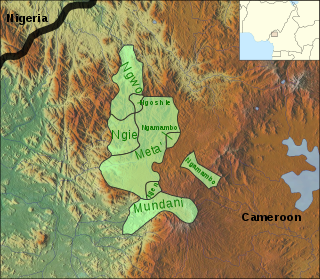
The Niger–Congo languages is the world's largest language family and Africa's largest in terms of geographical area, number of speakers, and number of distinct languages. It is generally considered to be the world's largest language family in terms of distinct languages, ahead of Austronesian, although this is complicated by the ambiguity about what constitutes a distinct language; the number of named Niger–Congo languages listed by Ethnologue is 1,540.

The approximately 450 Oceanic languages are a branch of the Austronesian languages. The area occupied by speakers of these languages includes Polynesia, as well as much of Melanesia and Micronesia. Though covering a vast area, Oceanic languages are spoken by only two million people. The largest individual Oceanic languages are Eastern Fijian with over 600,000 speakers, and Samoan with an estimated 400,000 speakers. The Kiribati (Gilbertese), Tongan, Tahitian, Māori, Western Fijian and Kuanua (Tolai) languages each have over 100,000 speakers. The common ancestor which is reconstructed for this group of languages is called Proto-Oceanic.
Tiv is a Southern Bantoid language spoken in Nigeria, with some speakers in Cameroon. It had 4 million speakers in 2015. Most Tiv speakers are found in Benue State in Nigeria. The language is also widely spoken in the Nigerian states of Plateau, Taraba, Nasarawa and Cross River as well as the FCT Abuja. It is by far the largest of the Tivoid languages, a group of languages belonging to the Southern Bantoid branch of Benue–Congo.

The Kadu languages, also known as Kadugli–Krongo or Tumtum, are a small language family of the Kordofanian geographic grouping, once included in Niger–Congo but since Thilo Schadeberg (1981) widely seen as Nilo-Saharan. Evidence for a Niger-Congo affiliation is rejected, and a Nilo-Saharan relationship is controversial. A conservative classification would treat the Kadu languages as an independent family.

There are over 500 native languages spoken in Nigeria. The official language of Nigeria is English, the former language of colonial British Nigeria. As reported in 2003, Nigerian English and Nigerian Pidgin were spoken as a second language by 60 million people in Nigeria. Communication in the English language is much more popular in the country's urban communities than it is in the rural areas, due to colonisation.

The Beboid languages constitute a branch, or branches, of Southern Bantoid and are spoken principally in southwest Cameroon, although two languages are spoken over the border in Nigeria. The Eastern Beboid languages may be most closely related to the Tivoid and Momo groups, though Western Beboid, if it's a group at all, may be closer to Ekoid and Bantu.
Montol is an Afro-Asiatic language spoken in Plateau State, Nigeria. Dialects are Baltap-Lalin and Montol. Roger Blench (2017) uses the name Tel or Tɛɛl for Montol.

The Kainji languages are a group of sixty or so related languages spoken by about 900,000 people in Nigeria. They form part of the Central Nigerian (Platoid) branch of Benue–Congo. Four of the largest are Tsuvadi (150,000), Cishingini and Tsishingini —all from the Kambari branch; and Clela (100,000), of the Northwest Kainji branch.
North Akoko, usually abbreviated as Akoko and also known as Arigidi, is a dialect cluster spoken in Nigeria. It appears to form a branch of the "Yoruba–Edo–Akoko–Igbo" group of Niger–Congo languages. It is spoken in the LGAs of Akoko North East, Akoko North West, Ekiti East, and Ijumu (Ethnologue).
Esimbi is a Southern Bantoid language of southwestern Cameroon. It's generally classified as Tivoid but with little evidence; it has just about as much in common with Grassfields languages. It is also called Isimbi, Simpi, Age, Aage, Bogue and Mburugam.
Buru is a Southern Bantoid language of uncertain classification spoken in a single village in Nigeria. It is spoken in Sardauna LGA, Taraba State, in a village near Batu.
Idun (Idũ), or Dũya, is a poorly attested Plateau language of Nigeria. Its classification is uncertain, but it may be closest to Ashe.
Amasi is a Southern Bantoid language of Cameroon.
Iyive, also referred to as Uive, Yiive, Ndir, Asumbos, is a severely endangered Bantoid language spoken in Nigeria and Cameroon. The ethnic group defined by use of this language is the Ndir.
Achama is a location in Cameroon located in the department of Momo in the Northwest Region. It is part of the commune of Widikum-Boffe and consists of two villages, Lower Achama and Upper Achama.









